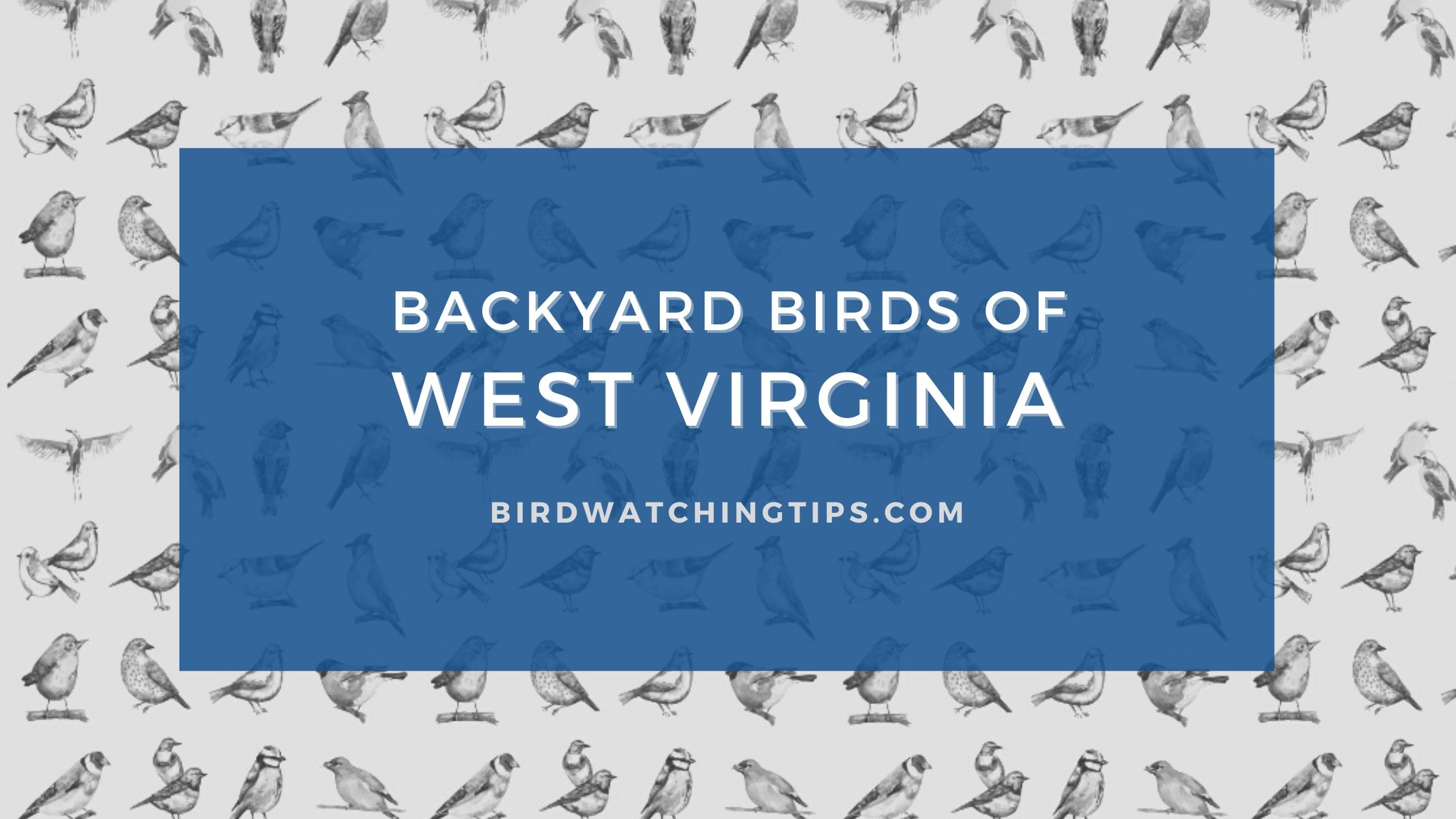With water-gap canyons, parallel ridges, as well as forests and even caves the Mountain State of West Virginia is a great place for birding, camping, or simply hiking out to enjoy some of the best scenery that nature has to offer. Today we are going to explore the birding action a bit as we discuss the popular backyard birds of West Virginia. We’ll let you know some of the most common visitors and give you the inside scoop on what they like to eat and where they like to hang their hats when they aren’t spending time in your backyard. Let’s talk about those West Virginia birds!
3 Categories – 369 Birds
With all of those beautiful surroundings birds come from all over to visit or even settle in West Virginia year-round and we’ll expand on this idea a bit by providing you a sampling of birds divided seasonally like this:
- Year-round Resident birds
- Birds of Spring, Summer, and Early Fall
- Fall and Winter Birds
We’ll follow up with feeding tips and identification data and after that we’ll even explore some hotspots where you can see these little angels in their native elements. Let’s get started with the long-term, year-round resident species you can encounter here.
West Virginia’s Year-round Resident birds
These birds took one look at all the lovely nature around them in the Mountain state and decided that they had found a home. Who could blame them, either? These birds may be spotted year-round with a little patience and the occasionally tech-advantage of a good pair of binoculars. See how many of these year-round resident birds you can spot this year:
- American Robin
- Mourning Dove
- European Starling
- Downy Woodpecker
- Eastern Towhee
American Robin – Turdus migratorius
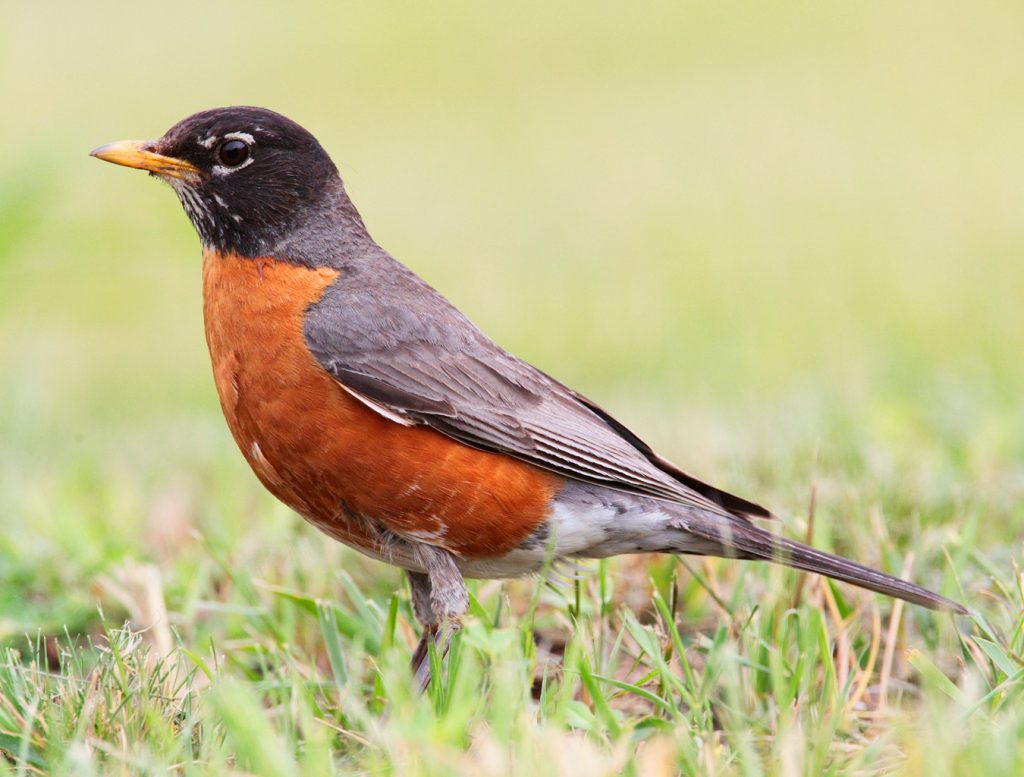
Coloration and Markings: American Robins have grayish-brown backs with medium-length wings and long, grayish-brown tails. They have white rumps but the underbelly and breast of this bird are a reddish-orange. Facially, the color goes to black, unbroken with the exceptions of a white eyering that looks as if it was dropped and shattered and a medium-length, slightly curved yellow bill that sometimes have a little black at its tip. Females will have the same color scheme but their colors will contrast much less than the males.
Size: These birds measure in at 7.9 – 11 inches from tip to tail and have wingspans of 12.2 to 15.8 inches wide.
Habitat: These birds prefer deciduous woods and are particularly fond of Pine stands as well. They may also be found anywhere that there is dense shrub cover and they aren’t shy about venturing into the suburbs. Look for them around golf courses, arboretums, parks, and backyards with fruit-filled feeders.
Diet: A Robin’s diet consists of 40% insects and 60% fruits, so you can try leaving out chopped apples, dried or live mealworms, and any types of berries that you might have on hand.
Mourning Dove – Zenaida macroura
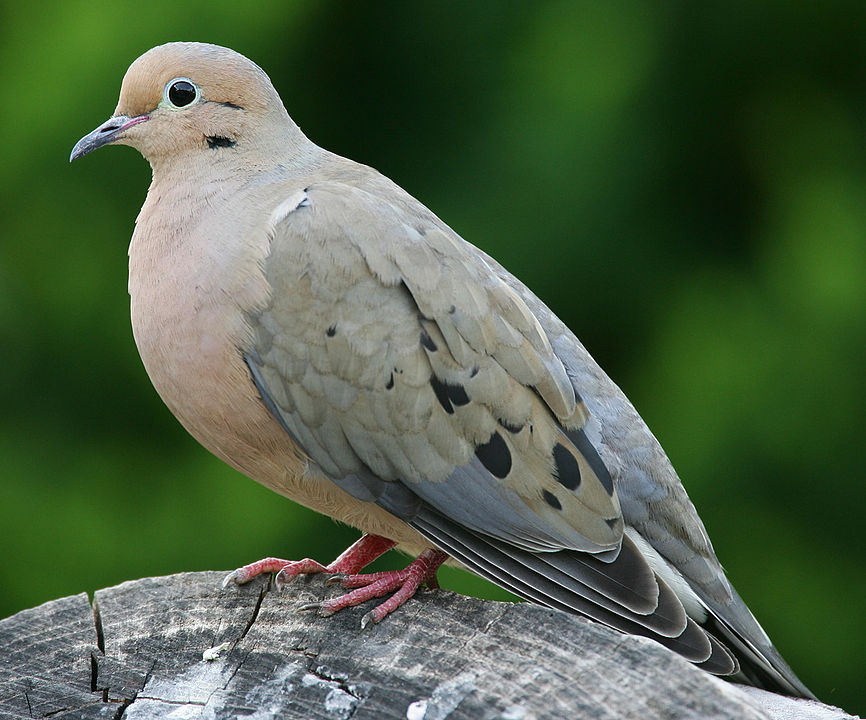
Coloration and Markings: Mourning Doves have gray backs and long, gray wings which have a heavy saturation of buffy tan color, along with distinctive large spots which are black in color. They have long, pointy tales, unique among North American Doves, and the underbelly and breast of this bird will be a mix of white with a creamy tan coloration. This tan is also heavily present in the face, where you will see a thin, white eyering as well, and this bird has a straight, medium length black bill.
Size: Roughly Robin-sized, these birds measure in at 9.1 – 13.4 inches in length and have wingspans of approximately 17.7 inches.
Habitat: These birds prefer the suburbs over the woods and the closest that you will find them will be in a farm setting. Barring this, look for them in the city, on sidewalks, fences, and phone lines. You can occasionally spot them in fields as well.
Diet: Black Oil Sunflower seeds, White Proso millet, and cracked corn are all favorites of the Mourning Dove. Leave one or more of these out and you might just make a new feathered friend.
European Starling – Sturnus vulgaris
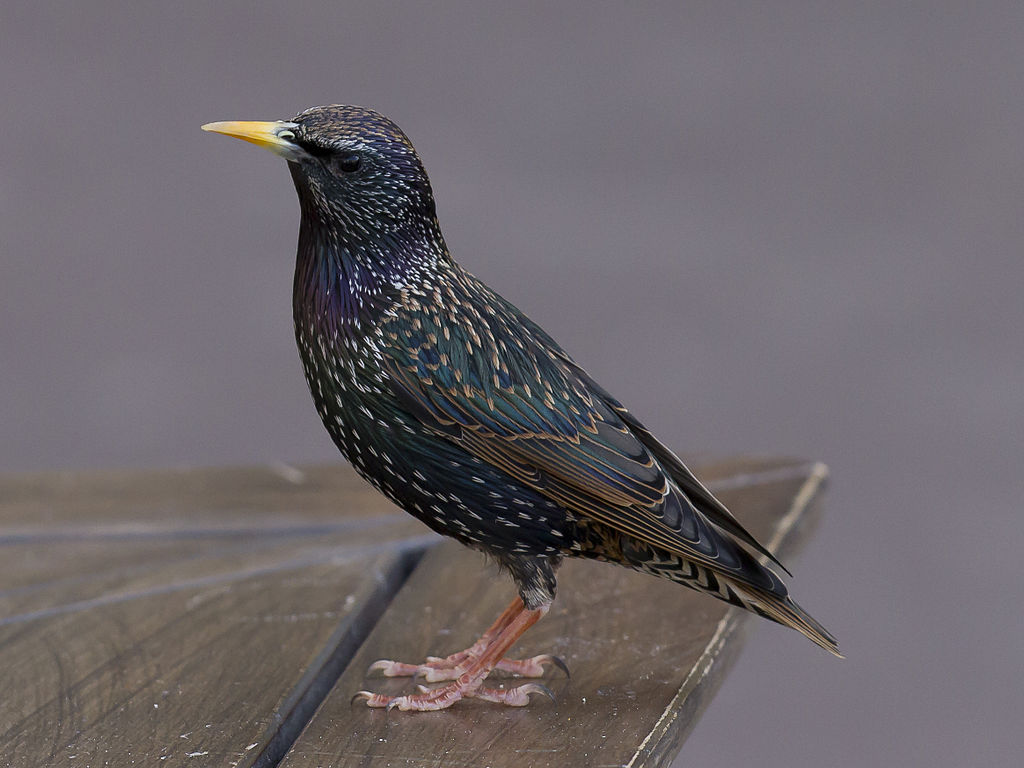
Coloration and Markings: European Starlings have two plumage configurations, one for when it is warm and another for winter. When it is warm, they look like regular Blackbirds from a distance but up close you can see that their plumage is a mixture of purples and greens, which are quite shiny and beautiful when they are close. These birds have long, straight yellow bills, and this can help you to tell a Starling from a distance until you are used to seeing them. In the winter they take on their second configuration of colors, adopting brow overall plumage which is accentuated with lovely white spots.
Size: About the same size as a Robin, Starlings measure 7.9 – 9.1 inches from head to tail and have wingspans of 12.2 to 15.8 inches in width.
Habitat: These birds have been around people for a long time, so don’t look for them in the woofind them in farms when you are in the country but if a town or city is nearby then this is their preferred place to forage.
Diet: These birds like wheat, rolled oats, and crushed peanuts if you have them and they are extremely fond of suet cakes (so put those out sparingly unless you are very well stocked on suet!).
Downy Woodpecker – Picoides pubescens
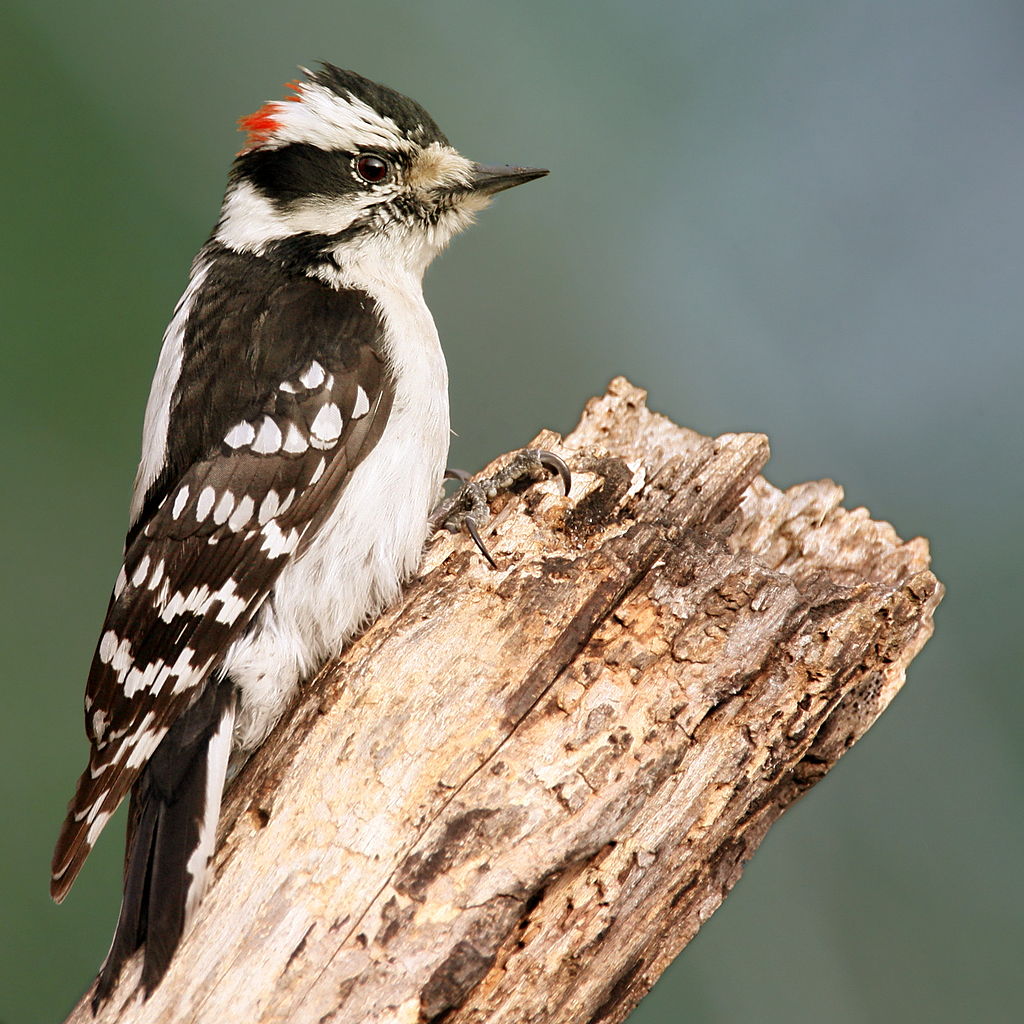
Coloration and Markings: Downy Woodpeckers have a wide swathe of white on their backs along with long, black wings, which carry spaced striping patterns made up of blocky white spots. This produces a lovely checkerboard effect that is hard to miss. They have small tails which are black above and white on the undersides and their underbelly and breast are a snowy white as well. Facially, these birds have mostly white faces with the exceptions of a black mustache line, a black ‘bandit’ mask that goes through the eyes and to the back of the head, and a black cap that extends to the end of the mask where it will display a red spot if you are viewing a male. These birds have thin, medium-length bills that look like the head of needle-nose pliers.
Size: Downies are the smallest North American Woodpeckers, measuring 5.5 – 6.7 inches in length and with wingspans of 9.8 to 11.8 inches.
Habitat: These birds like deciduous woods, especially when there is some brush cover nearby, but you can also spot them foraging in fields. They like to drop from branches straight into the high grass and feeds sometimes when foraging and it’s really a sight to see. These birds range out often and you can also find them in orchards, parks, and backyards with well-stocked feeders.
Diet: Shelled peanuts and suet, especially a fruit-blend suet, are favorites of the Downy Woodpecker. Leave one or both of these out and you might just make a tiny new friend.
Eastern Towhee – Pipilo erythrophthalmus

Coloration and Markings: Eastern Towhees have black backs and small, black wings and long, black tails. The wings and tail will have white accents in the plumage but it is typically sparse. The breast and underbelly of this bird are white with a heavy flanking of brownish-red color. Facially, this bird is sooty black, and the black will carry down past the throat to create a V-shape in the breast. You can also see a small, black crest sometimes if you are lucky. These birds have often display red eyes and they have stout, medium-length, conical black bills. Females will have the same patterns with the exception that brown will replace the black displayed in the males.
Size: These birds measure in at 6.8 – 8.2 inches in length and have wingspans of 7.9 to 11 inches wide.
Habitat: Eastern Towhees are birds of brushes, bushes, brambles, and thorns. Look for them anywhere that the vegetation is dense.
Diet: Black Oil Sunflower seeds, White Proso millet, and crushed peanuts can lure the Eastern Towhee to a backyard feeder, just be sure to use a ground feeder and sprinkle a little seed on the ground below to help to get their attentions.
West Virginia’s Birds of Spring, Summer, and Early Fall
When Virginia Bluebells and the Green Violets start carpeting the local scenery then you know that spring is here and in full force. During this time many a bird will be arriving, with others waiting for summer, until early fall when it’s time to start moving again. See if you can spot on of these birds during the warmer months:
- Scarlet Tanager
- Indigo Bunting
- Cape May Warbler
- Summer Tanager
- Hooded Warbler
Scarlet Tanager – Piranga olivacea
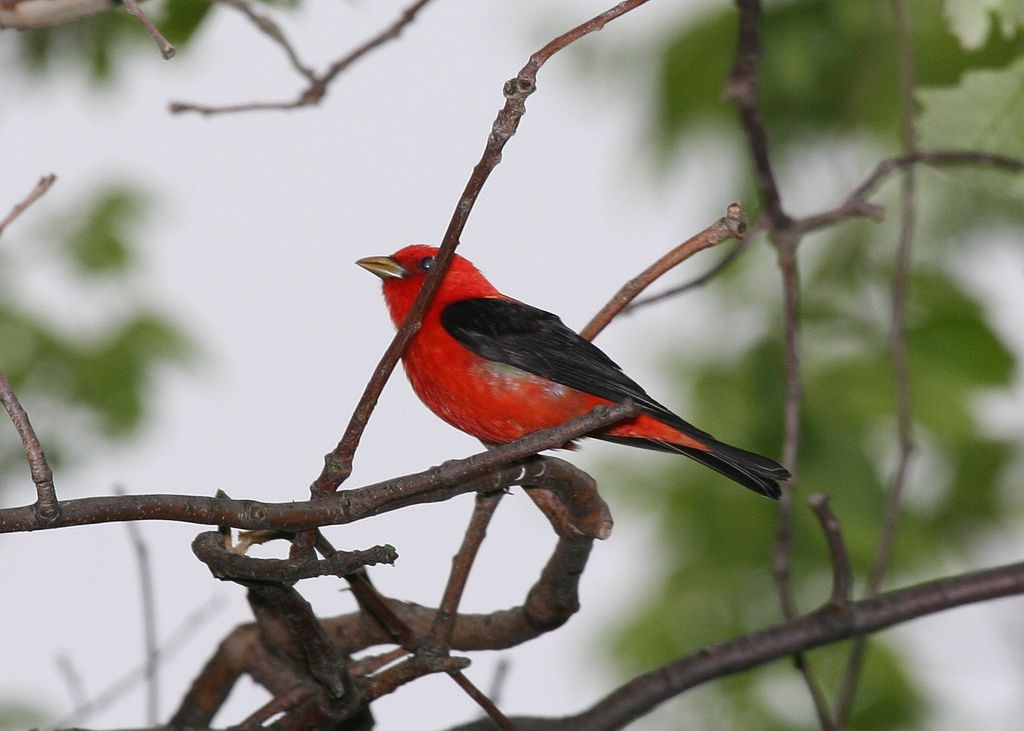
Coloration and Markings: Scarlet Tanager males have brilliant red backs with short, black wings which sometimes have a mark of yellow and a few touches of red present. They have short, forked tails, and their underbelly and breast are a rich scarlet as well, Facially, these birds have the deepest red concentration and they have stout, medium-length yellow to yellow-black bills. Females and juveniles tend to be an olive yellow color instead of red and after breeding season the male adopts this plumage as well, though they will retain their black wings and tails as a telltale-sign of the bird’s gender.
Size: These birds measure in at 6.3 – 6.7 inches in length and have wingspans of 9.8 to 11.4 inches wide.
Habitat: When it is warm, Scarlet Tanagers prefer to spend their time in deciduous or mixed forests of the deciduous and evergreen variety. They do range out sometimes and may also be spotted in orchards, parks, and backyards.
Diet: Orange-halves, fresh bananas, and suet cakes are all favorites of the Scarlet Tanager which are easy to provide and can lure these lovelies in for a closer look.
Indigo Bunting – Passerina cyanea

Coloration and Markings: Male Indigo Buntings have a stunning indigo blue coloration all over their bodies, though on occasion you might see a little gray if these birds are molting. They have medium-length wings which make their short tails look a little longer and facially, you will notice that the indigo color is at its richest and you can see a little black just in front of the bird’s eyes. These birds have stout, medium-length, conical silver bills. Females and juveniles will have different coloration to look for, with females the plumage will be brown instead of blue (though splashes of blue will present throughout) and the throat will be light in color. The female’s underbelly and breast will be off-white with olive streaking as well. Juveniles will be a mix of blue and brown patches, turning more and more blue as the bird gets older.
Size: These diminutive beauties measure in at 4.7 – 5.1 inches in length and have wingspans of 7.5 to 8.7 inches in width.
Habitat: These birds love the forest’s edge, especially if there is shrub cover nearby. These birds can also be spotted around hedges, fields, parks, and the occasional backyard.
Diet: Cracked corn, Rye and oats, and Nyjer thistle are all favorites of the Indigo Bunting.
Cape May Warbler – Setophaga tigrina
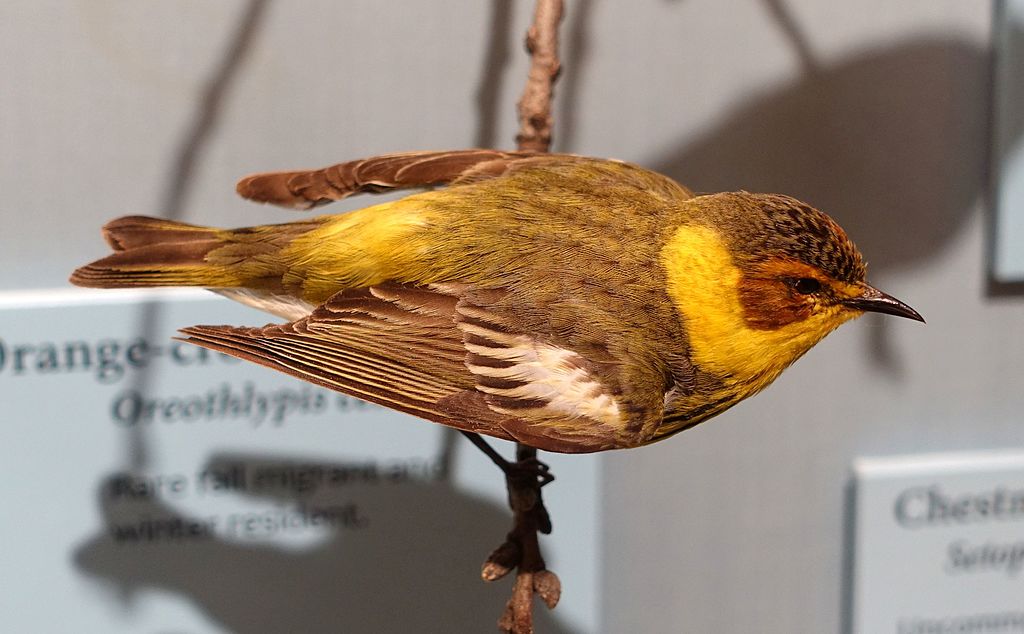
Coloration and Markings: Cape May Warblers have olive gray and yellow backs and medium length wings and short tails of the same color. A white patch is present on each wing and while the rump of this bird is grayish-white with a touch of yellow the underbelly and breast will be a mix of heavy yellows, with some minor white and with ‘tiger stripe’ olive streaking present throughout. Facially, this bird has a mostly yellow face with an olive crown and a thin, olive eyeline along with a thick, curved brown line underlining the eyes. These birds have thin, medium-length, straight black bills will a light curve present on the upper bill. Females and juveniles will have muted coloration and typically displaying yellow-green rumps.
Size: These little birds measure in at 4.7 – 5.1 inches in length and have wingspans of 7.9 to 8.7 inches.
Habitat: During mating season these birds prefer to spend their time in boreal forests, though afterwards they range out just about anywhere that there is some dense cover in the form of bushes, brambles, high grasses, or shrubs.
Diet: Grape jelly and actual grapes are an easy lure for the beautiful Cape May Warbler. Try putting one or both out and see what happens!
Summer Tanager – Piranga rubra
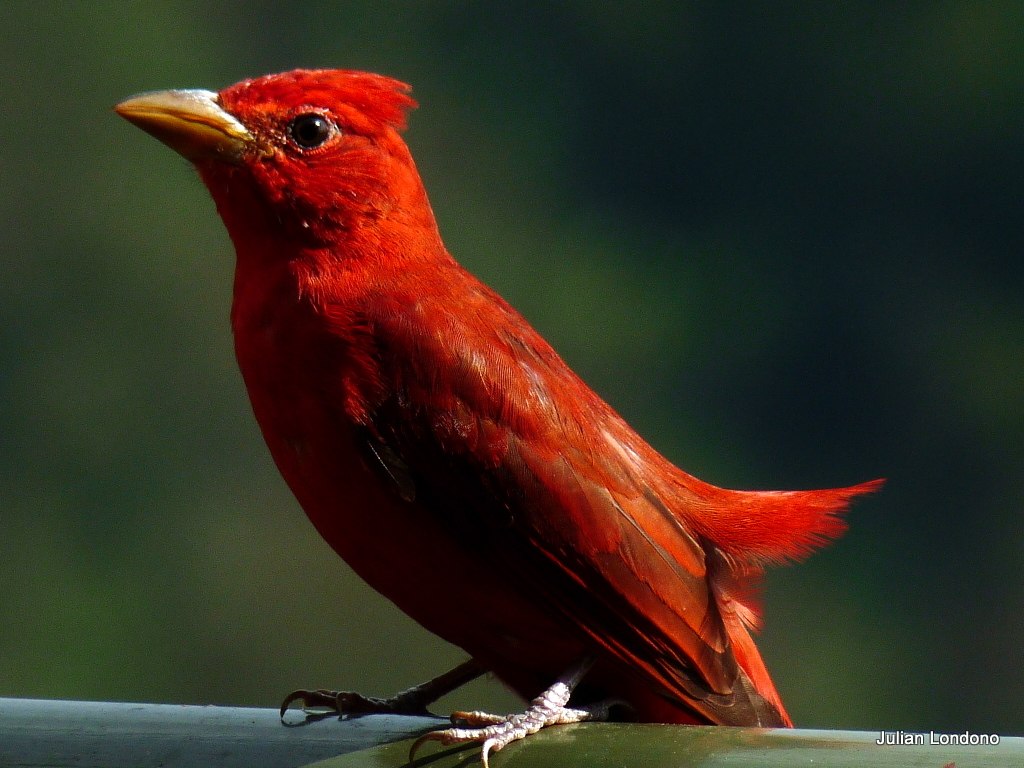
Coloration and Markings: Male Summer Tanagers are easy to identify and have amazing plumage. They are completely a rich red color and have medium-length wings as well as long, perky tails. Facially, they have large and stout pale bills, and females and juveniles will have very different color. They will display yellowish green plumage with a concentration of yellow in the face and more gren present on the back and wings.
Size: These birds average approximately 6.7 inches from tip to tail and have wingspans of about 12 inches wide.
Habitat: These birds love open woods, expecially deciduous or pine and oak mix varieties. Look for them here, especially if streams or rivers are nearby as these birds are fond of water.
Diet: These birds like peanut butter, cornmeal, and suet, so they are quite easy to please. Be sure to leave a little something out to let them know that you would like them to visit.
Hooded Warbler – Setophaga citrina
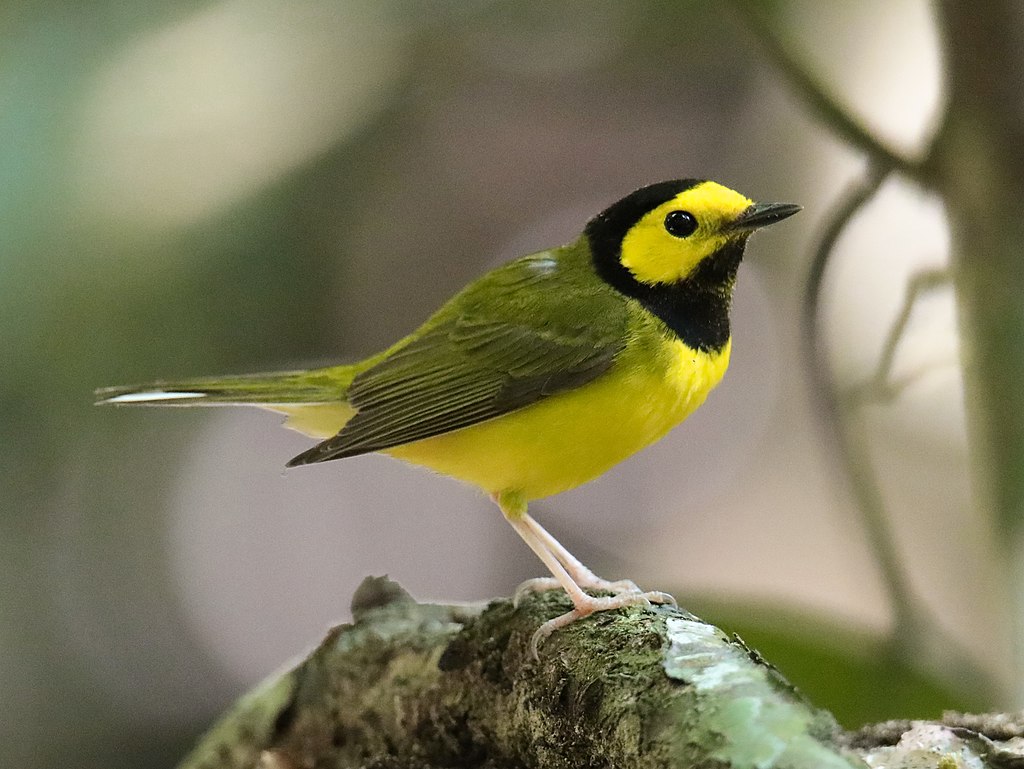
Coloration and Markings: Hooded Warblers have olive green backs with short, olive and gray wings as well as long, gray tails with some white outer feathers. The underbelly and breast of this bird are a delightful bright yellow and facially, they have a black hood which v’s into the breast though the center of their face (forehead and cheeks) will be a bright yellow. This brings out their black eyes and they have long, thin, and straight black bills.
Size: These little birds measure in at approximately 5.1 inches from head to tail and have wingspans averaging 6.9 inches in width.
Habitat: Hooded Warblers may be found in any type of forest with dense enough shrub cover. They do favor older deciduous woods whenever possible.
Diet: These birds rarely visit feeders, subsisting primarily on a diet of insects, but you can sometimes lure them in by smearing a little suet on the bark of a tree and hanging a suet feeder, cage or another type, nearby.
West Virginia’s Fall and Winter Birds
Those mountains mean that weather changes can come quick and with a vengeance and with winter lows of around 18 degrees Fahrenheit you are soon down to around 50 tough species of birds who bat nary an eye at the temperature drop and just keep on foraging. Here are a few of those birds so that you can keep an eye out and a supportive snack for them:
- Dark-eyed Junco
- Carolina Chickadee
- American Crow
- Evening Grosbeak
- Purple Finch
Dark-eyed Junco – Junco hyemalis

Coloration and Markings: Dark-eyed Juncos can have a number of small regional variance in plumage but you base set for identification is this. Juncos typically have dark brown or gray backs, with medium-length wings and long tails of the same color. The tails will be white on the sides and on the undersides and the underbelly and breast of this bird are white as well, with a small flanking of gray or brown at the underbelly that increases in thickness as the color moves up the breast. When the bird is at rest the white often appears to be evenly distributed in the lower regions of the bird. Facially, this bird is dark brown or gray and have a medium-length, conical pink bill.
Size: These birds measure in at 5.5 – 6.3 inches in length and have wingspans of 7.1 to 9.8 inches wide.
Habitat: During the warmer months these birds favor coniferous and mixed coniferous woods though they range out quite often, so you can look for them in fields, parks, and backyards as well. This is especially true in the winter months.
Diet: White proso millet, Black Oil Sunflower seeds, and cracked corn are 3 easy examples of effective lures for the Dark-eyed Junco.
Carolina Chickadee – Poecile carolinensis
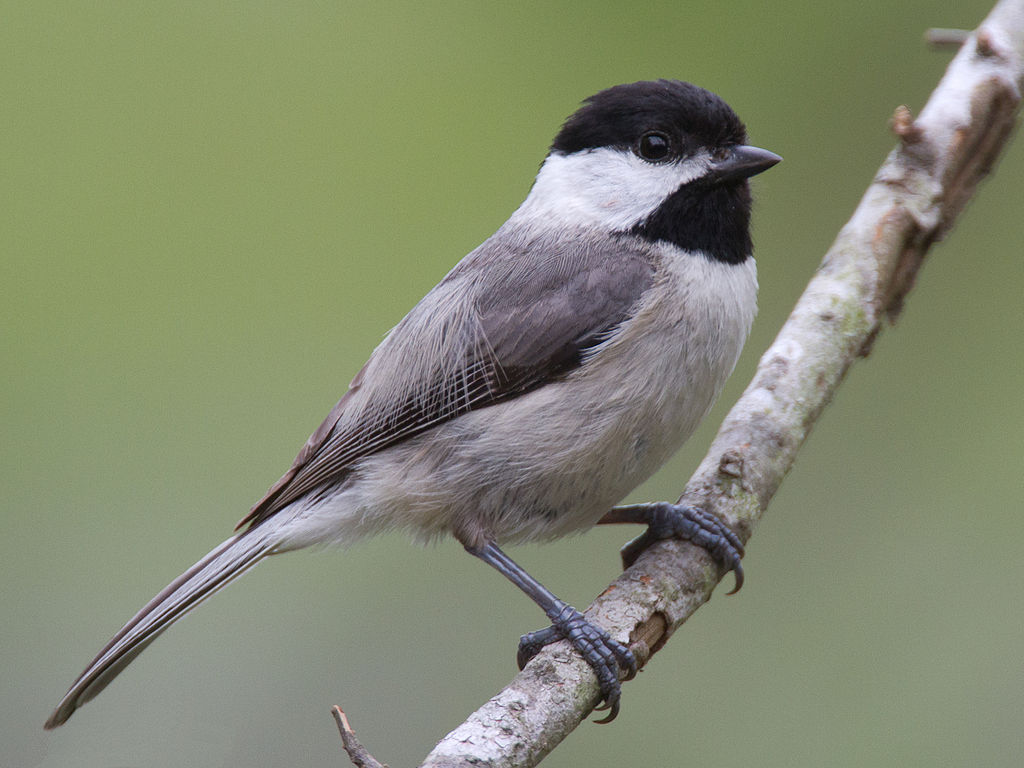
Coloration and Markings: Carolina Chickadees have velvety gray backs with medium-length gray wings and long, thin gray tails with some white at the undersides. They have a snowy white underbelly and breast and facially they are white as well, with the exception of a small black bib and the distinctive, namesake large black cap. The cap comes down to about mid-eye level across the face. These birds have small, thick, triangular black bills.
Size: These diminutive beauties measure in at 3.9 – 4.7 inches in length and have wingspans of 5.9 to 7.9 inches wide.
Habitat: These birds are comfortable in the woods or in the city, as long as there are a few large trees about where they can perch high and feel safe.
Diet: A treat you can make easily for the Carolina Chickadee is suet cakes rolled in crunchy peanut butter. These little birds love it!
American Crow – Corvus brachyrhynchos

Coloration and Markings: The American Crow is instantly recognizable, preferring to dress in completely matching plumage of black, black, and more black, which even includes their legs and feet! Crows have long wings and long tails and facially, they have large, long, and stout black bills which are straight but show a visible curve on the upper bill. If you see a Crow that looks a little brown don’t worry, it’s not sick, just molting into some new black plumage.
Size: These are fairly large birds, measuring in at 15.8 – 20.9 inches in length and with wingspans of 33.5 to 39.4 inches.
Habitat: American Crows love the open woods but they are just at home at farms or around the city. Look for these wily, winged-Einsteins on phone lines and fence posts as they scope out the area for snacks and mischief-making.
Diet: Suet mixed with Safflower seeds is a favorite for wily, playful Crows, but you can also just leave out some cracked corn, buckwheat, and rolled oats and they will still love you for it.
Evening Grosbeak – Coccothraustes vespertinus
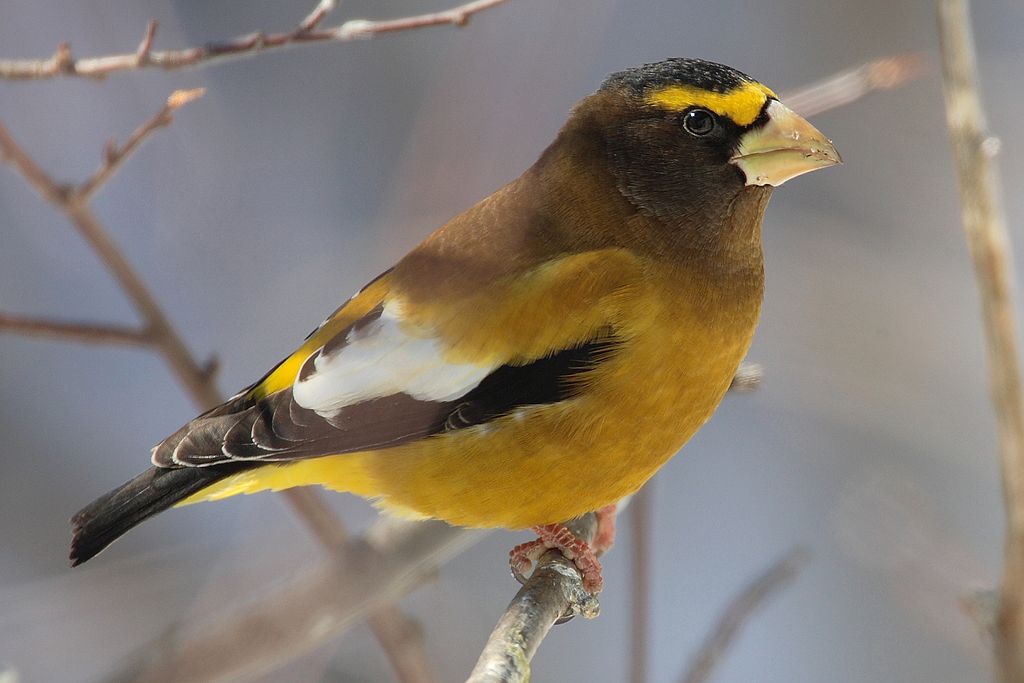
Coloration and Markings: Male Evening Grosbeaks have olive colored backs, with yellow shoulders on their long, black wings. A large white patch is also present, which bears somewhat of a shield-shape when the bird is at rest. They have small, black tails with some yellow on the undersides, and the underbelly and breast of this bird are a ‘dirty’ yellow color as well. Facially, they have brownish heads with lighter color saturation at the cheeks, as well as black caps and a large, yellow stripe over each eye. These birds have large, thick, and conical yellow ‘aged-ivory’ bills. Females and juveniles will be mostly soft gray on top and lighter on the bottom, with white-patched black wings and with some greenish yellow around the collar.
Size: These birds measure in at 6.3 – 7.1 inches in length and have wingspans of 11.8 to 14.2 inches wide.
Habitat: These birds prefer deciduous and coniferous woods, typically at higher elevations, but they tend to range a little randomly and are frequent visitors to backyard feeders during this time.
Diet: Evening Grosbeaks are easy to please, just leave out some Black Oil Sunflower seeds and a little suet and you are ready to host them as visitors.
Purple Finch – Haemorhous purpureus
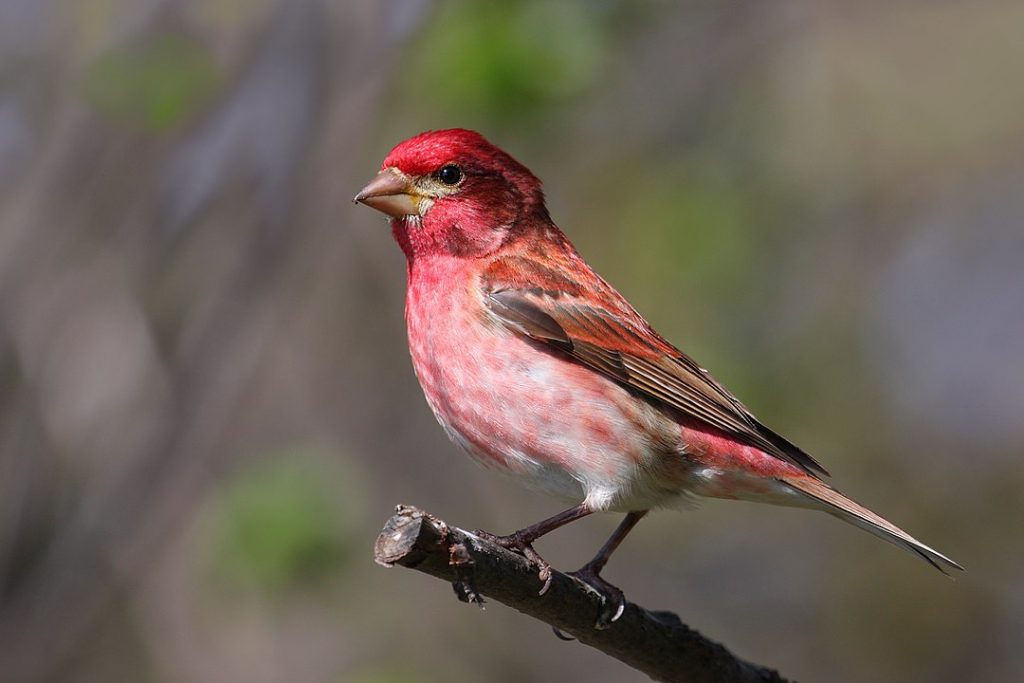
Coloration and Markings: Male Purple finches look like brown birds that took a swim in a raspberry river. They have reddish-pink and brown backs, with medium-length wings and short, notched tails. Both will be brown and reddish-pink and 2 thin white wingbars are present on each wing and you can sometimes spot this if you look closely. The rump of this bird is pure white but the underbelly will be white with pink streaking and towards the breast this becomes a heavy saturation of pinkish-red color. Facially, this bird is mostly a light raspberry color, with the exceptions of darker color at the top of the head, starting just behind the forehead, and a thick, dark raspberry eyestripe that curls down, thins, and circles the cheek, terminating at the lower bill. Female Purple Finches will not have the raspberry color, but are rather an olive color on top, with whitish breast and underbelly marked by heavy olive streaking, and with a white eyeline and a wide white ‘mustache stripe’ present. A dark, olive stripe is often present going from the bill to the throat as well. These birds have stout, medium-length, conical bills which tend to be pinkish yellow to yellow and sometimes have a little black on the tips.
Size: These birds measure in at 4.7 – 6.3 inches in length and have wingspans of 8.7 to 10.2 inches.
Habitat: When it’s warm these birds prefer the comforts of deciduous or coniferous and deciduous mixed woods. They do range out, especially in winter, where you can spot them at the forest’s edge, in fields, or in backyards where they’ve been made to feel full and welcome.
Diet: Black Oil Sunflowers seeds mixed with Nyjer thistle are an excellent and easy way to please a hungry Purple Finch.
Supporting cast (Other Backyard Birds of West Virginia that might pay you a visit)
Just in case you don’t spot one of the front-page year round birds we have a whole ‘Supporting cast’ of lovely Avians that are just waiting for you to spot them year-round as well! They are just as lovely and are eager to please you with their antics, just don’t forget to leave a little something out for them to show your appreciation. Watch out for these ‘Supporting cast’ birds this year:
- American Goldfinch
- Tufted Titmouse
- Eastern Bluebird
- Red-bellied Woodpecker
- White-breasted Nuthatch
American Goldfinch – Spinus tristis

Coloration and Markings: Male American Goldfinches have bright yellow backs and long, black wings which display 2 white wingbars on each wing as well as some vertical white marks towards the lower-center portion of the inner wing. They have short, notched tails which display white markings on top and white rumps. The underbelly and breast of this bird are bright yellow, as is the bird’s face, but for 2 exceptions. The first is a forehead-cap which is black and looks quite jaunty and the second exception is the medium-length, conical orange bill. Females tend to be more of an olive color with some yellows present and in winter both genders molt into new, rather dull brown plumage. Their distinct wingbars, however, will be dimmed but quite present to help you identify them.
Size: These birds measure in at 4.3 – 5.1 inches in length and have wingspans of 7.6 to 8.7 inches in width.
Habitat: These birds love overgrown fields, especially if they are prone to flooding and thus great areas for foraging. They range out often, visiting local orchards, parks, and backyards, so be sure to leave4 a little something out for the American Goldfinch.
Diet: These Finches love it when you mix peanut butter with suet cakes. Give this a try and see for yourself, you’ll like the results!
Tufted Titmouse – Baeolophus bicolor
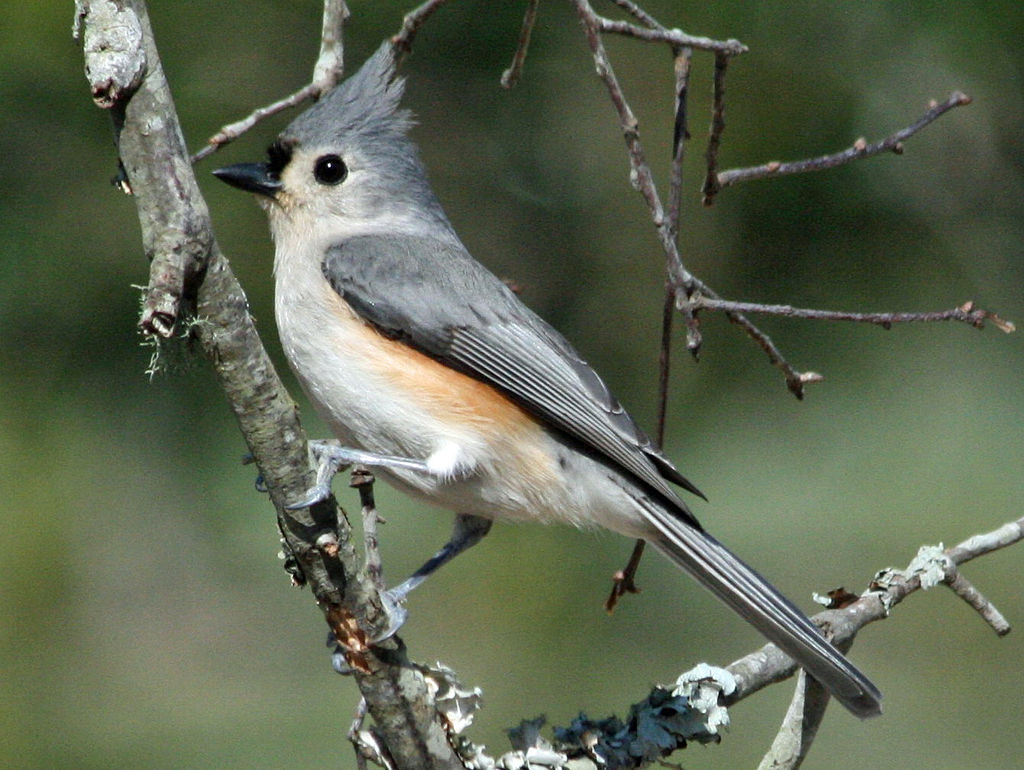
Coloration and Markings: The Tufted Titmouse has a blue-gray back with small blue-gray wings and a long blue-gray tail. The underbelly and breast of this bird are white, with a light but distinctive peach flanking present if you look closely. Facially, the lower portion of the face is white and the eyes are outlined in white as well, with the upper portions and the back of the head being a silvery-blue color. This bird has a tiny, but lovely crest and you will also notice a large, black spot just above the small, stout, and straight black bill.
Size: These birds measure in at 5.5 – 6.3 inches in length and have wingspans of 7.9 to 10.2 inches wide.
Habitat: These little acrobats prefer the comforts of deciduous and evergreen woods though they range out quite often, visiting parks, gardens, orchards, and backyards.
Diet: Black Oil Sunflower seeds seem to be this bird’s favorite feeder food, though they will also settle for peanuts and suet if you’ve got them.
Eastern Bluebird – Sialia sialis
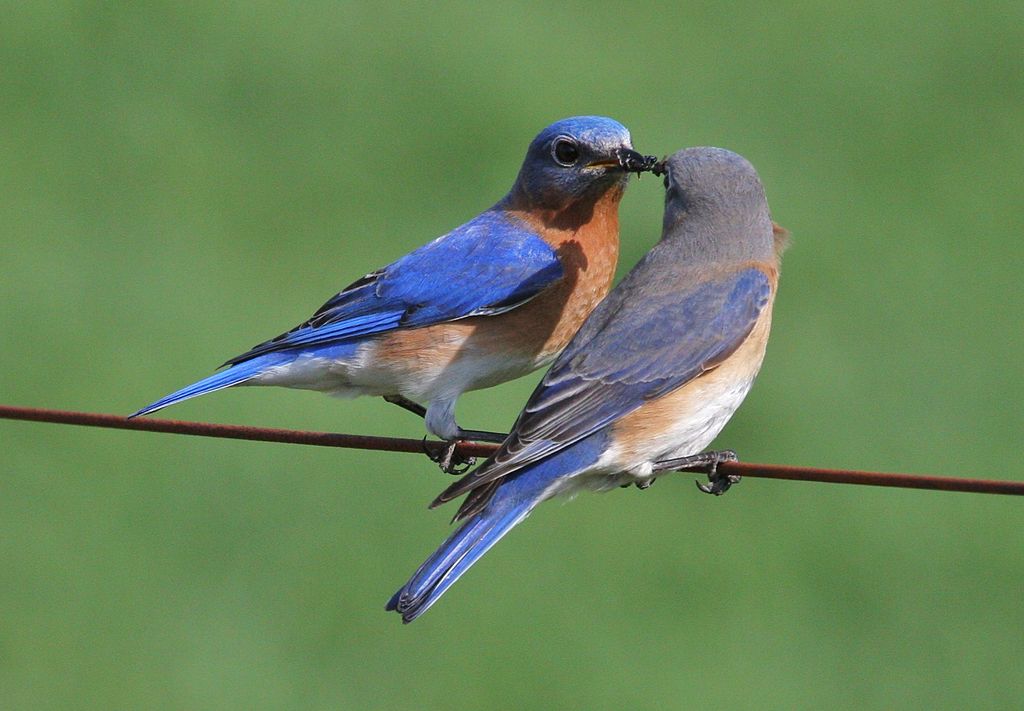
Coloration and Markings: Male Eastern Bluebirds have lovely deep-blue backs, with long, blue wings and short, blue tails. The rump of this bird is pure white but the underbelly and breast will have a flanking of orange-brown color that greatly increases in density at the breast, carrying up into the throat where it stops vertically, terminating horizontally just behind the shoulders. The remainder of the face is blue with the exception of a grayish chin and these birds have medium-length, lightly curved, black or silvery bills. Females will have gray faces and grayish wings, with some tinges of blue, and the orange-brown color will be somewhat muted.
Size: These birds measure in at 6.3 – 8.3 inches in length and have wingspans of 9.8 to 12.6 inches wide.
Habitat: These birds love open areas of the forest, such as meadows, clearings, and copses. They are especially receptive to nesting boxes as well so if you’d like a new tenant you might want to prepare a little home in the backyard and see if you get lucky!
Diet: Chopped apples, Black Oil Sunflower seeds, and suet are all welcome additions to your backyard feeder where the Eastern Bluebird is concerned.
Red-bellied Woodpecker – Melanerpes carolinus

Coloration and Markings: Red-bellied Woodpeckers have a striking Zebra-stripe pattern on their backs, their long wings, and on their short, stout tails. The breast and underbelly of this bird are white with splashes of red, as well as a distinct red spot present on the underbelly. Facially, this bird’s head is mostly white with some splashes of red around the cheeks and a red cap that extends down to the nape of the neck. These birds have long, stout, straight black bills.
Size: These birds measure in at an average length of 9.4 inches and have wingspans of 13 to 16.5 inches.
Habitat: These Woodpeckers are comfortable in most woods but they do favor Hickory, Pine, and Oak stands when they are present. They are bold birds that range often and are frequent visitors of backyard feeders.
Diet: Black Oil Sunflower seeds, suet, and your secret weapon… grape jelly! Leave these 3 out and you might look out one day to see a happy Red-bellied Woodpecker in your own backyard!
White-breasted Nuthatch – Sitta carolinensis

Coloration and Markings: White-breasted Nuthatches have bluish-gray backs, with medium-length bluish-gray wings and short blue-gray tails which are white on the undersides. At the underbelly this bird is white but with a distinctive chestnut spot that is easy to miss and the breast of this bird is white as well. Facially, this birds has a mostly white head with the exception of a thin, black line going from the back of the eye and upwards diagonally and this bird has a black cap, the color of which carries down to the nape of the neck and towards the shoulders. This bird has a long, straight bill that is typically black on top and whitish on the bottom.
Size: These birds measure in at 5.1 – 5.5 inches in length and have wingspans of 7.9 to 10.6 inches in width.
Habitat: These birds love to spend their time in the woods and are partial to deciduous stands, especially Oak, Maple, and Hickory.
Diet: Suet, peanut butter (especially crunchy), and Black Oil Sunflower seeds are all favorites of the White-breasted Nuthatch.
West Virginia Bird Buffet
When you are looking for that perfect feeder combination it always helps to have a little advice. The West Virginia University Extension service has a lovely article on the subject entitled “Backyard Feeding Basics” and we’ll share a little of their advice and throw in some of our own to help you get started on your perfect backyard feeder for West Virginia birds. If you’d like to read their article in its entirety, be sure to check out reference links and in the meantime try adding one or more of the following to see what birds you may attract:
- Sorghum
- Milo
- Black Oil and Striped Sunflower seeds
- Grape Jelly
West Virginia Birding Hot Spots
While you can always lure birds into your backyard it is a special treat to catch glimpses or even photos of your favorite feathered friends out in the wild like a real Chirparazzo. The places we’ve listed below can provide you with a chance to do exactly that and if you don’t see anything close, just check out the provided reference link. There are many, many place in West Virginia that are absolute birding gems just waiting for you to experience them. Try visiting one of these birding hotspots when you’ve got a little time to yourself:
- Northern hotspot – Panhandle Trail
- Eastern hotspot – East Fork Trail (WV)
- Southern hotspot – Potts Valley Rail Trail
- Western hotspot – Little Kanawha Connector Trail
- Central hotspot – Elizabeth J. Binky Poundstone Memorial River Trail
Detailed descriptions of each location as well as information regarding visiting and what birds you can see at these locations may be found at https://www.traillink.com/stateactivity/wv-birding-trails/
Some Last Words
Today we have briefly touched on the subject of the popular backyard birds of West Virginia. As you can see, this is a great place to be a birder and we hope that you are taking advantage of the vast opportunities which the Mountain state provides. Just be sure to pack a full lunch, bring your binoculars, and don’t forget your patience… before you know it you might just be adding a new, prized siting to your list! Happy birding, West Virginia Birders, we wish you the best!
